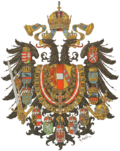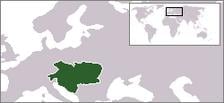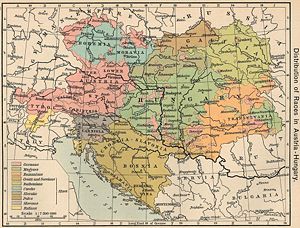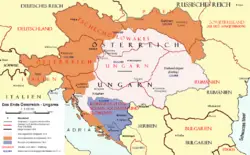Austria-Hungary
| |||||||||||||||||||||||||||||||||||||||||||||||||||||||||||||||||||||||||||||
The union of Austria and Hungary, also known as the Dual (that of Emperor of Austria and King of Hungary) Monarchy, was a dualistic state (1867 ‚Äď1918 C.E.) in which Austria and Hungary each had a parliament to manage their domestic affairs. A joint cabinet then handled foreign affairs, military affairs, and finances.
The newly created Austro-Hungarian Empire was a good example of a marriage of convenience. The Italian and German campaigns for national unification altered the balance of power in continental Europe. These campaigns challenged the dominance of Austria's Habsburg Monarchy. Austria's defeat at the hands of French and Piedmont forces in 1859 and its crushing loss to Prussia in the Seven Weeks' War crippled Austria's influence in Europe and encouraged resistance within the borders of its empire. Faced with the dual threat of a rapidly industrializing German state and a unified Italy, Austria courted a new political partner to prevent the further erosion of its power. During the revolutions of 1848, Magyar leaders of Hungary and Czech leaders from Bohemia had asserted their independence from Austrian rule. Austrian military forces crushed the Czech revolt but the Hungarian Republic held out, until the arrival of 100,000 Russian troops helped the Austrian forces to prevail. In an effort to remain a world power and consolidate its crumbling empire in central and eastern Europe, Austria joined with Hungary to form the unusual alliance called the Austro-Hungarian Empire. This lasted 51 years before it was dissolved after World War I.
| Austro-Hungarian Empire | |
|---|---|
| Official Long names (and English translation thereof) | |
| en: The Kingdoms and Lands Represented in the Imperial Council and the Lands of the Holy Hungarian Crown of Saint Stephen
de: Die im Reichsrat vertretenen Königreiche und Länder und die Länder der heiligen ungarischen Stephanskrone hu: A birodalmi tanácsban képviselt királyságok és országok és a magyar Szent Korona országai |
It was the rise of local mono-cultural nationalisms that led to the break-up of the Empire, when Slav nationalism resulted in the assassination of Archduke Franz Ferdinand, heir to the Austrian throne on June 28, 1914 and Austria-Hungary was catapulted into the armed conflict that became World War I. The post-World War II European space of a European Union of states with free movement of people and of goods and pan-European human rights legislation at its center could be seen as resurrecting the Austro-Hungarian model. Many of the states that emerged, or re-emerged, as separate entities after the Empire's collapse are now members of the European Union.
The Lands and Peoples of the Empire
Many texts refer to the non-Hungarian ("Austrian") half part of Austria-Hungary as Cisleithania‚ÄĒbecause most of its territory lay west (or to "this" side, from an Austrian perspective) of the Leitha river (although Galicia to the north-east also counted as "Austrian"). This region (consisting of more than simply Austria) strictly speaking had no collective official name prior to 1915, and hence official sources referred to the "Kingdoms and Lands Represented in the Imperial Council." (The Imperial Council (Reichsrat) functioned as Cisleithania's parliament.) Similarly, the Transleithanian ("Hungarian") half also consisted of more than simply Hungary, and bore the official designation of the "Lands of the Holy Hungarian Crown of Saint Stephen" (Stephen I of Hungary) - a reference to the canonized first Christian king of Hungary.
All told, within the boundaries of the Austro-Hungarian Empire lived Austrian Germans, the Magyars of Hungary, Czechs, Slovenes, Poles, Slovaks, Romanians, Ruthenians, Serbs, and Croats. Its people practiced the Roman Catholic, Protestant, Eastern Orthodox, and Muslim religions. Little other than geography held these groups together.
Creation of Austro-Hungarian Empire ‚ÄĒ The Compromise of 1867
As in all through the history, the ambitions and fate of main protagonists of the mightiest political powers play the most important roles. So, in the European theatre of nineteenth century there was first Napoleon’s defeat and exile in 1814, upon which the Congress of Vienna in 1815 re-established the House of Habsburg and its territories. Especially agile in all this was the Austrian chancellor, prince Clemens von Metternich, who, by a combination of conflict and diplomacy, made the Austrian Habsburg Empire the leading power on the continent, only to be swept aside by the 1848 rebellions in Europe, which forced many Royal houses to allow limited constitutional and social reforms.
Much more fateful was, however, the antagonism between Habsburgs and Hohenzollerns (Prussian) dynasties that started already well before in 1740. At question was the domination of the Deutcher Bund, a group of German speaking political entities in Europe, with the Austrian Emperor as its head. Thus, the then Prussian premier Otto von Bismarck used all the guile and political talent and eventually achieved‚ÄĒespecially after crushing defeat of Austrian army at Graz in 1866‚ÄĒthat Austria ceded Italy Venezia dynasty, Holstein to Prussia, and agreed to dissolve the Deutsche Bund. The way to eventual Greater Germany under Prussia , with all its later world wars, has thus begun. This may have been the final push for the Austrian Emperor to agree to the ‚ÄúCompromise.‚ÄĚ
The Ausgleich ("Compromise") of February 1867 which inaugurated the Empire's dualist structure in place of the former unitary Austrian Empire (1804-1867) originated at a time when Austria had declined in strength and in power‚ÄĒboth in the Italian peninsula (as a result of the Austro-Sardinian War of 1859) and in greater Germany (culminating in the Austro-Prussian War of 1866). Other factors in the constitutional changes included continued Hungarian dissatisfaction with rule from Vienna, and increasing national consciousness on the part of other nationalities of the Austrian Empire. Hungarian dissatisfaction grew partially from Austria's suppression, with Russian support, of the Hungarian liberal revolution of 1848‚Äď1849. However, dissatisfaction with Austrian rule had grown for many years within Hungary, and had many causes.
In an effort to shore up support for the monarchy, Emperor Franz Joseph of Austria began negotiations for a compromise with Hungary's Magyar nobility to ensure their support. Some members of the government, such as Austrian prime minister Richard von Belcredi, advised the Emperor to make a more comprehensive constitutional deal with all of the nationalities that would have created a federal structure. Belcredi worried that an accommodation with the Magyar interests would alienate the other nationalities. However, Franz Joseph was unable to ignore the power of the Hungarian nobility, and they would not accept anything less than dualism between themselves and the traditional Austrian elites.
In particular, they received the Emperor's coronation as King of Hungary, a separate parliament at Budapest with the powers to enact laws for the historic lands of the Hungarian crown (the lands of Stephen I), though on a basis which would preserve the political dominance of ethnic Hungarians (more specifically of the country's large nobility and educated élite) and the exclusion from effective power of the country's large Romanian and Slavic minorities: Slovaks, Bulgarians and other Balkan Slavs.
Governmental structure
Three distinct elements ruled the Austro-Hungarian Empire:
- a unified administration under the monarch
- the ‚ÄúAustrian‚ÄĚ or Cisleithanian government, and
- the Hungarian government.
Austria and Hungary maintained separate parliaments, each with its own prime minister. Linking/co-ordinating the two fell to a government under a monarch, wielding power absolute in theory but limited in practice. The monarch’s common government had responsibility for the army, for the navy, for foreign policy, and for the customs union.
Within Cisleithania and Hungary certain regions, such as Galicia and Croatia, enjoyed special status with their own unique governmental structures.
A Common Ministerial Council ruled the common government: it comprised the three ministers for the joint responsibilities (joint finance, military, and foreign policy), the two prime ministers, some Archdukes and the monarch. Two delegations of representatives, one each from the Austrian and Hungarian parliaments, met separately and voted on the expenditures of the Common Ministerial Council, giving the two governments influence in the common administration. However, the ministers ultimately answered only to the monarch, and he had the final decision on matters of foreign and military policy.
Overlapping responsibilities between the joint ministries and the ministries of the two halves caused friction and inefficiencies. The armed forces suffered particularly from overlap. Although the unified government determined overall military direction, the Austrian and Hungarian governments each remained in charge of "the quota of recruits, legislation concerning compulsory military service, transfer and provision of the armed forces, and regulation of the civic, non-military affairs of members of the armed forces." Needless to say, each government could have a strong influence over common governmental responsibilities. Each half of the Dual Monarchy proved quite prepared to disrupt common operations to advance its own interests.
Relations over the half-century after 1867 between the two halves of the Empire (in fact the Cisleithan part contained about 57 percent of the combined realm's population and a much larger share of its economic resources) featured repeated disputes over shared external tariff arrangements and over the financial contribution of each government to the common treasury. Under the terms of the Compromise, an agreement, renegotiated every ten years, determined these matters. Each build-up to the renewal of the agreement saw political turmoil, however.
Ethnic relations
|
The ethnic distribution | |||
|
Czechs (the majority in the Czech lands, i.e., Bohemia, Moravia and Austrian Silesia), Poles and Ukrainians (in Galicia (Central Europe)Galicia), Slovenes (in Carniola, Carinthia and southern Styria, mostly today's Slovenia) and Croats, Italians and Slovenes in Istria each sought a greater say in Cisleithan affairs.
At the same time, Magyar dominance faced challenges from the local majorities of Romanians in Transylvania and in the eastern Banat, of Slovaks in today's Slovakia, of Croats and Serbs in the crownlands of Croatia and of Dalmatia (today's Croatia), in Bosnia and Herzegovina and in the provinces known as the Vojvodina (today's northern Serbia). The Romanians and the Serbs also looked to union with their fellow-nationalists in the newly-founded states of Romania (1859 - 1878) and Serbia.
Language was one of the most contentious questions in Austro-Hungarian politics. In fact, although the German language was never officially enacted as the "state" language, all governments faced difficult and divisive hurdles in sorting out the languages of government and of instruction. Minorities wanted to ensure the widest possibility for education in their own language as well as in the "dominant" languages of Hungarian and German.
The Hungarian government seemed especially unforgiving in these matters. From January 1907 all the public and private schools in the Slovak part (approx. three million people) of Hungary were forced to teach in Hungarian language only, burning Slovak books and newspapers. This led to wide criticism by Bj√łrnstjerne Bj√łrnson among others.
It was not rare for the two kingdoms to divide spheres of influence.
Internal politics
The Settlement of 1867 (also known as the Compromise of 1867) provided Habsburg rulers with a more stable empire in the short run by securing strength through numbers. The empire retained its place as a great power in Europe. Vienna later became a center for the modernist thrust in art, music, and psychology.
However, the constitutional reforms, enacted in 1867, gave the general citizenry legal rights as never before and, probably, unparalleled, at least in the Czech part of the Empire in the last 50 years of the twentieth century. The Emperor (Franz Josef 1st) made the Imperial Council, previously only an advisory entity, the only legal arbiter and, de iure, the parliament with ultimate legislative and control authority of its deputies. Owing to the lobby of, mostly, German bourgeoisie deputies, the new constitution now featured: installing universal law and order for everybody without exception, such as: freedom of conscience and of religion, freedom to assemble or to gather, freedom of speech, freedom of scientific research, freedom of movement, principle of universal equality vis-√†-vis the law, inviolability of personal property. This represents the dream of every developing country in the twenty-first century. Apart from that, the judicial system was completely overhauled with the decreed (and generally upheld in practice) independence of judges on all levels and the ‚Äúimperial court of law‚ÄĚ was established to process complaints of citizens against the lawlessness of the regional (or local) governments. One very important element in this democratization process was enactment of the mandatory eight-year school-attendance and the abolition of church-control over the school system.
While the franchise was limited by gender (men only) and by social status (there were land-owning requirements) what was emerging, as argued by Lieven (2002) was a different sort of empire, one that was more of a multi-national democratic federation than a large territory held together by fear and coercion. The original union was created from the top-down, by the Austrian Emperor but it developed into what amounted to an experiment in multi-national governance. Lieven states, 'the 1867 compromise with Hungary was not made by "Austria," whatever that might mean, but by its monarch, whose power was… close to absolute' (186). However, by 1900, to a 'unique extent' Austro-Hungary was becoming 'a multi-national democratic federation, able to offer its peoples the economic benefits of a huge market, legally protected equality in status, and the security that was the Empire's traditional boon' (193).
Economy
The Austro-Hungarian economy changed dramatically during the existence of the Dual Monarchy. Technological change accelerated industrialization and urbanization. The capitalist mode of production spread throughout the Empire during its 50-year existence. The old institutions of feudalism continued to disappear. Economic growth centered around Vienna, the Austrian lands (areas of modern Austria), the Alpine lands, and the Bohemian lands. In the later years of the nineteenth century rapid economic growth spread to the central Hungarian plain and to the Carpathian lands. As a result of this pattern wide disparities of development existed within the Empire. In general the western areas achieved far more development than the east. By the early twentieth century most of the Empire had started to experience rapid economic growth. The GNP per capita grew roughly 1.45 percent per year from 1870 to 1913. That level of growth compared very favorably to that of other European nations such as Britain (1.00 percent), France (1.06 percent), and Germany (1.51 percent) (see Good: 1984). However, the Empire's economy as a whole still lagged considerably behind the economies of other powers, as it had only begun sustained modernization much later. Britain had a GNP per-capita almost three times larger than the Habsburg Empire, while Germany's stood almost twice as high as Austria-Hungary's. Nonetheless, these large discrepancies hide different levels of development within the Empire.
Rail transport expanded rapidly in the Austro-Hungarian Empire. Its predecessor state, the Habsburg Empire, had built a substantial core of railways in the west originating from Vienna by 1841. At that point the government realized the military possibilities of rail and began to invest heavily in their construction. Bratislava, Budapest, Prague, Kraków, Graz, Laibach (Ljubljana), and Venice became linked to the main network. By 1854 the Empire had almost 2000 kilometres of track, about 60 to 70 percent of it in state hands. At that point the government began to sell off large portions of track to private investors to recoup some of its investments and because of the financial strains of the 1848 Revolution and of the Crimean War.
From 1854 to 1879 private interests conducted almost all rail construction. What would become Cisleithania gained 7952 track kilometres, and Hungary built 5839 track kilometres. During this time many new areas joined the railway system and the existing rail networks gained connections and interconnections. This period marked the beginning of widespread rail transportation in Austria-Hungary, and also the integration of transportation systems in the area. Railways allowed the Empire to integrate its economy far more than previously possible, when transportation depended on rivers.
Foreign policy
The territory of the Austro-Hungarian Empire expanded still further when the Russians defeated the Ottoman Turks in 1878. An international congress (the Congress of Berlin) was held to divide up the last Ottoman possessions. Austria-Hungary was given permission to administer the territories of Bosnia and Herzegovina, with other territories being divided up equally amongst the other powers and some becoming independent, with the most prominent of these independent states being Serbia. Lieven (2002) notes that while the Austro-Hungarian empire had one of the lowest military budgets they did not lose any territory in the five decades before 1918 and actually gained Bosnia and Herzegovina (341).
In the meantime,the rise of a united Germany had created a German power to match that of the Austro-Hungarian empire. Defeated in a short conflict over control of some German states, the Austro-Hungarian Empire aligned itself with the united states of Germany. In 1879, Germany (which meant: Prussia) and the Empire signed a formal alliance, joined by Italy in 1882. The pact was called the Triple Alliance.
The Imperial (Austrian) and Royal (Hungarian) governments differed also to some extent in their attitude toward the Empire's common foreign policy. Politicians in Budapest particularly feared annexations of territory which would add to the kingdom's non-Hungarian populations. But the Empire's alliance with Germany against Russia from October 1879 and the above mentioned Triple Alliance commanded general acceptance, since Russia seemed the principal external military threat to both parts.
Austro-Hungarian forces occupied the territory of Bosnia and Herzegovina from August 1878 under the 1878 Treaty of Berlin. The Empire annexed this territory in October 1908 as a common holding under the control of the finance ministry rather than attaching it to either territorial government. The annexation set up an anomalous situation which led some in Vienna to contemplate combining Bosnia and Herzegovina with Croatia to form a third component of the Empire, uniting its southern Slav regions under the domination of Croats (who might have proved more sympathetic to Vienna than to Budapest.
World War I
On June 28, 1914, Franz Ferdinand, Archduke of Austria‚ÄĒheir presumptive to his uncle the Emperor Franz Josef I of Austria (Franz Josef's only son had died under still-mysterious circumstances‚ÄĒvisited the Bosnian capital Sarajevo. The Crown Prince Ferdinand, supporter of greater autonomy for Serbs and other ethnic minorities within the Empire, became a target of Bosnian Serb militants and the nationalist group The Black Hand assassinated him and his wife.
The Empire thus very reasonably sought to punish Serbia for at minimum providing the rhetoric that inspired the assassins, and more likely (and, in reality) directly aiding them. Had the negotiations been held in good faith, it is likely that a compromise would have been reached. For example: Serbia agreed to halt all support for dissidents within the Austro-Hungarian Empire, and punish the guilty. They were not being held in good faith. Germany had thus given the Empire a "carte blanche" to impose whatever ultimatum it wanted, with the assurance that Germany would back it up. The Empire decided to crush Serbia once and for all, and absorb it into their empire.
Russia, in turn, reacted in its tradition role of protector of the Slavic people (which included the Serbs), so when Serbia turned to Russia for military support, Russia agreed, in part fearing the "loss of face" if it let its small ally down.
France and Russia were allies. The German military had one, and only one, plan for fighting a major war, the Schlieffen Plan, which involved the immediate invasion of France via Belgium and Luxembourg, in an all-out bid to defeat France in 40 days. Thus, when countries started to mobilize, the Kaiser gave the go-ahead to the Schleiffen plan, and the war was on. This action of the German government contrasted with that of the French, who, despite the protests of the Army, ordered all troops to pull back 10 kilometers from the border in the days before war was declared, in order to prevent any sort of incident from accidentally sparking a war.
Austro-Hungarian troops initially crushed Serbia, defended the routes into Hungary and repulsed Italian advances in Gorizia. The Austro-Hungarian Army suffered very serious casualties throughout the war, especially in 1914. However, they had considerable successes (albeit with German aid and direction) even advancing into enemy territory following German-led victories in Galicia (May 1915) and at Caporetto on the Italian front (October 1917). Throughout the war, the Austro-Hungarian war effort had become more and more subordinate to the direction of German planners. Supply shortages, low morale, and the high casualty rate began to seriously affect the operational abilities of the army by the last years of the war. Eventually, the defeat for the Austro-Hungarian armies on the battlefields of the First World War and mutinies and rebellions at home caused the Austro-Hungarian Empire to a sudden and a dramatic break-up.
Dissolution of the Empire
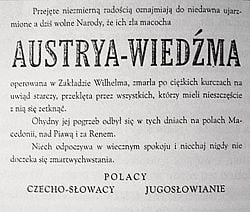
After the failure of the Spring Offensive the tide of war turned decisively against the Central Powers. Although the leadership of the national minorities in the Empire had remained loyal to the Habsburgs throughout the war, worsening fortunes forced them to reconsider their options. As it became apparent that the Allies would win, it became politically expedient for nationalists to renounce ties to the old state and to embrace the nationalist ideology of the victorious powers. On top of that, the Empire could no longer provide an incentive for the nationalities to work together. Other groups also lost faith in the Empire. Prosperity had disappeared, disillusioning business interests, socialists became upset by the loss of the liberal policies that had characterized the pre-war Cisleithanian government. Under those conditions radical nationalists found it easy to rally support to their cause, and a rash of declarations of independence followed in September ‚Äď October 1918. The war officially concluded for Austria-Hungary when it entered an armistice with the Allies on November 3, 1918.
The end of the war marked the end of the Austro-Hungarian Empire. It became politically expedient for the allied victors to break the conglomeration up into various national components in accordance with Woodrow Wilson's Fourteen Points. The allied powers by no means saw the break-up of the empire as a war aim: they seriously entertained the idea only towards the end of the war. In fact, it is now known that T.G. Masaryk, future president of the Czechoslovakia, wanted and promoted a sort of "Swiss cantonal" political arrangement among the national minorities (vying for independent states), only to be "badgered" by Wilson to accept the complete independent statehood for everybody.
Contrary to expectations at the time, the break-up of the empire did not alleviate national problems in the area, and made the area more politically unstable than under Habsburg rule.
First to formalize the new circumstances, the Czechs and the Slovaks proclaimed independence on October 28, 1918. Hungary followed suit on October 31, although Transylvania's majority joined Romania, taking with them a large Hungarian minority. The South Slavs had formed the State of Slovenes, Croats and Serbs on 29 October, soon united (December 1, 1918) with Serbia and Montenegro as the Kingdom of Serbs, Croats and Slovenes (later Yugoslavia).
After the war the victors reorganized the borders in the area, radically changing political alignments. Different treaties affected the area, including the Treaty of Trianon (1920).
Both Austria and Hungary became republics, exiling the Habsburg family in perpetuity. A pro-monarchist revival in Hungary after the communist revolution and the Romanian intervention of 1919 led to the country's formal reversion to a kingdom (March 1920), but with the throne vacant. Attempts by the last Emperor, Charles I, to regain power in Budapest (March, October 1921) ended in his deportation to Madeira, Portugal, where he died the following year. In the absence of a king, Hungary fell under the control of a regency, headed by the naval hero Miklós Horthy.
The following new states formed themselves (in part or in full) out of the former Habsburg lands:
- Austria
- Czechoslovakia
- Hungary
- State of Slovenes, Croats and Serbs (joined with the Kingdom of Serbia on 1 December 1918 to form the Kingdom of Serbs, Croats and Slovenes, later Yugoslavia)
- Poland
In addition, some Austro-Hungarian territory went to Romania and Italy. Liechtenstein, which had formerly looked to Vienna for protection, formed a customs and defence union with Switzerland, and adopted the Swiss currency instead of the Austrian. In April 1919 Vorarlberg, the westernmost province of Austria, voted by a large majority to join Switzerland; however both the Swiss and the Allies ignored the vote.
Historiography
Historical views of Austro-Hungarian Empire have varied throughout the 20th century:
Historians in the early part of the century tended to have emotional and/or personal involvement with the issues surrounding Austria-Hungary. Nationalist historians tended to view the Habsburg polity as despotic and obsolete. Other scholars, usually associated with the old government, became apologists for the traditional leadership and tried to explain their policies.
- Major writers from the early period who remain influential include: Oskar J√°szi and Josef Redlich.
Subsequent experience of the region's inter-war "Balkanization]," of Nazi occupation, and then of Soviet domination, led to a more sympathetic interpretation of the Empire, based primarily in a large exiled community in the United States. Marxist historians still tended to judge the Empire in a negative way. One way or the other, the legal system (inclusive of basic liberties) introduced after 1867 has to this day became the envy of every single developing country and many a developed.
One controversy among historians remains: whether the Empire faced inevitable collapse as the result of a decades-long decline; or whether it would have survived in some form in the absence of military defeat in World War I.
- Alan Sked (2001) says that no inevitable demise can be argued; rather, the Empire fell because it lost a war.
- David F. Good supports Sked's view.
Territorial legacy
The current countries whose entire territory were located inside Austria-Hungary by the time of the dissolution of the empire are:
The current countries whose part of their territory were located inside Austria-Hungary by the time of the dissolution of the empire are:
- Poland (voivodships of Silesia, Lesser Poland and Subcarpathia)
- Ukraine (oblasts of Zakarpattia, Lviv, Ivano-Frankivsk, Ternopil and Chernivtsi)
- Romania (region of Transylvania and the county of Suceava)
- Serbia and Montenegro (autonomous province of Vojvodina in Serbia and the city of Kotor in Montenegro)
- Italy (autonomous regions of Trentino-Alto Adige and Friuli-Venezia Giulia)
See also
Notes
- ‚ÜĎ Citype - Internet - Portal Betriebsges.m.b.H. Austro-Hungarian Empire 1867 - 1918. Wien-vienna.com. Retrieved November 22, 2011.
- ‚ÜĎ Volksz√§hlung vom 31. Dezember 1910, ver√∂ffentlicht in: Geographischer Atlas zur Vaterlandskunde an der √∂sterreichischen Mittelschulen. K. u. k. Hof-Kartographische Anstalt G. Freytag & Berndt, Wien 1911.
- ‚ÜĎ Ethnographic map of the Austro-Hungarian Monarchy, 1910. Thomasgraz.net. Retrieved November 22, 2011.
ReferencesISBN links support NWE through referral fees
- Good, David F. The Economic Rise of the Habsburg Empire: 1750-1914. Berkeley, CA: University of California Press, 1984. ISBN 0520050940
- Lieven, Dominic. Empire: The Russian Empire and Its Rivals. New Haven, CT: Yale University Press, 2002. ISBN 0300097263
- Sked, Alan. The Decline and Fall of the Habsburg Empire, 1815-1918. New York, NY: Longman, 2001. ISBN 0582356660
External links
All links retrieved August 22, 2023.
- "Distribution of Races in Austria-Hungary" from the Historical Atlas by William R. Shepherd, 1911
- Maps of Austria-Hungary
Credits
New World Encyclopedia writers and editors rewrote and completed the Wikipedia article in accordance with New World Encyclopedia standards. This article abides by terms of the Creative Commons CC-by-sa 3.0 License (CC-by-sa), which may be used and disseminated with proper attribution. Credit is due under the terms of this license that can reference both the New World Encyclopedia contributors and the selfless volunteer contributors of the Wikimedia Foundation. To cite this article click here for a list of acceptable citing formats.The history of earlier contributions by wikipedians is accessible to researchers here:
The history of this article since it was imported to New World Encyclopedia:
Note: Some restrictions may apply to use of individual images which are separately licensed.

